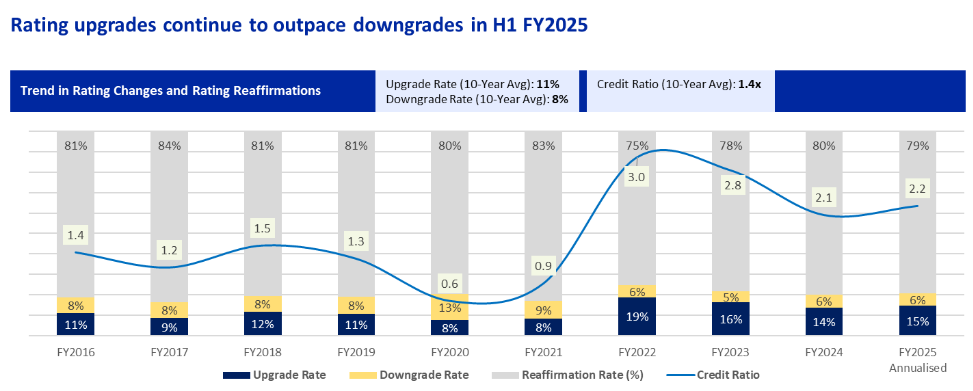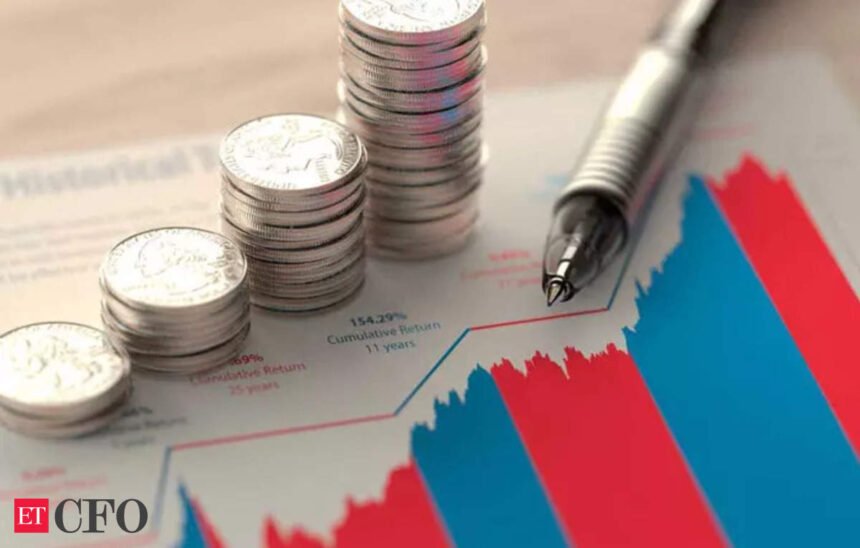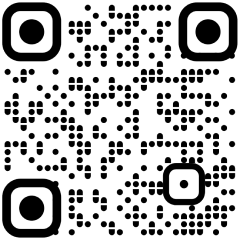[ad_1]

The first half of FY2025 saw a positive credit environment for India Inc, with more companies experiencing credit rating upgrades than downgrades. The Credit Ratio, which represents the number of upgrades to downgrades, stood at 2.2x.
ICRA estimated India’s GDP growth of 7.0% in FY2025. Inflation is expected to moderate to 4.5%, while the fiscal deficit is projected to shrink to 4.9%.
| India Inc’s credit rating varies from 0.9 in FY21, 3.0 in FY22, 2.8 in FY23, 2.1 in FY24, to 2.2 in H1 of FY24. |
Sector wise Credit Ratio – H1 of FY25
| Sector | Credit Ratio |
| Financial Sector | 3.4 |
| Power | 2.9 |
| Hospitality | 12 upgrades, NIL downgrades |
| Chemicals & Petrochemicals | 0.4 |
| Textiles & Apparels | 0.3 |
Source: ICRA
What is driving India Inc’s credit upgrade?
ICRA’s report released on Tuesday stated that improving business fundamentals, rather than temporary market conditions, have been the main drivers of these upgrades. In H1 FY25, around 50% of the rating upgrades were attributed to the growth in profits, supported by economies of scale, successful project completions, and reduced project-related risks.
The credit quality of India Inc remains steady, and in the past six months, there hasn’t been an imperative to change the outlook on any sector. There are some emerging pockets of concern, however, like an expansion in household debt, growth in unsecured lending, with early signs of rising delinquencies in unsecured retail and microfinance segments.K Ravichandran, Chief Rating Officer, ICRA
Only 10% of the upgrades were driven by favourable industry conditions, primarily in the hospitality sector, where demand has significantly outpaced supply, leading to higher occupancy rates and room prices.Despite an increase in borrowing costs of around 160 basis points (1.6%) between April 2022 and September 2024, companies have managed to keep rating downgrades in check.
India Inc witnessed the strong profit growth, supported by lower raw material costs, particularly for sectors such as steel and cement. These industries have been able to offset declines in product prices with reduced input costs, maintaining healthy profit margins.

How is de-leveraging faring out for India Inc?
According to the report, companies have been actively reducing their debt levels, even as they continue to invest in new projects.
Among a sample of 2,500 companies, capital expenditure increased by 34% in the five years leading up to FY2024. However, debt levels did not rise at the same rate due to prudent financial management. As a result, the total debt to PBDIT ratio improved from 3.0x in March 2020 to 1.8x in March 2024.stated ICRA report.
The report also showed the low number of defaults in ICRA’s portfolio during H1 FY2025. There were five defaults, with four of these in the non-investment grade category, indicating that riskier companies were responsible for most defaults.
The only investment-grade default occurred due to an operational issue with a Housing Finance Company.
Risks
ICRA identifies a few risks as the rise in household debt, increased unsecured lending, and early signs of rising delinquencies in the unsecured retail and microfinance segments.
Export-dependent sectors like chemicals and cut & polished diamonds are also facing challenges due to softening demand and profitability pressures.
[ad_2]
Source link











